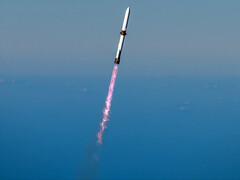The Blue Origin space exploration company that is backed by Jeff Bezos managed to complete a maiden flight of a reusable rocket booster.
While the landing on a barge in the ocean happened about ten years after Elon Musk's SpaceX managed to bring back its own Falcon rocket safely for the first time, the New Glenn booster of Blue Origin is quite a bit larger. It towers 190 feet and has a diameter of 23 feet, against Falcon's respective 135 feet and 12 feet dimensions, as the New Glenn rocket is Blue Origin's latest orbital vehicle generation meant for heavy lifting. It is also way larger than the reusable Yanxingzhe-1 rocket that China managed to bring back for the first time over the summer.
Besides the successful recovery of an orbital-class rocket booster, which SpaceX's Jon Edwards called an "incredibly difficult" feat while congratulating the team, Jeff Bezos managed to launch something towards Mars ahead of his archrival in space exploration, Elon Musk, who has also set his sight on Mars.
NASA Mars mission with Blue Origin
NASA's Escape and Plasma Acceleration and Dynamics Explorers (ESCAPADE) mission used the Blue Origin reusable booster test mission to take two Mars probes into orbit. The first stage separated about three minutes after the liftoff and started falling down through the Earth's atmosphere. A few minutes later, it fired some of its BE-4 engines to slow down and correct course, and then safely landed the New Glenn rocket booster on a dedicated recovery barge that was splashing in the Atlantic Ocean 375 miles below the stage separation point.
The second stage of the rocket continued to launch the two Mars orbiters of NASA into space about 33 minutes after liftoff. Labelled Blue and Gold, the identical spacecraft began hurtling towards the Lagrange-2 point of Earth-Sun gravitational stability that is located 930,000 miles away. The probes will circle back to use the Earth's gravitation as a slingshot to hurl them towards Mars during the next available window, about a year from now.
This novel concept of languishing in Lagrange-2 while a suitable Earth-Mars launch window comes has allowed NASA to use the Blue Origin reusable rocket test flight to launch its probes ahead of said window that only opens once every 26 months. The two Mars probes that Jeff Bezos launched for NASA will be used to examine the Red Planet's atmosphere or, more precisely, the way it disappears due to solar wind and other factors.
Mars may have kept water on its surface thanks to its atmosphere once, but subsequent thinning likely contributed to its evaporation, and UC Berkeley's Space Sciences Laboratory that initiated the ESCAPADE mission wants to know where the atmosphere it went with the help of the two probes that Blue Origin launched.
SpaceX is still testing its Starship 3 rocket that is meant to start Mars missions during the next available window in 2026, but the NASA probes launched by Blue Origin are likely to get there first. "We built a high delta V system that not only cruises to Mars and performs the Mars orbit insertion maneuver, but first climbs out of the Earth's gravity well, eliminating the need for Mars direct transfer from the launch vehicle, significantly increasing the available launch options," rejoiced Richard French, the VP of Rocket Lab that developed the Mars probes for NASA.
Besides the Mars launch window conundrum resolution, Rocket Lab brags that it managed to keep the costs of the ESCAPADE mission down to only $18 million per unit, both for crafting the probes and for their launch, a very low price tag made possible by the new Blue Origin orbital vehicle.













